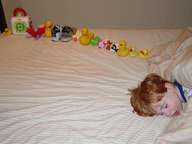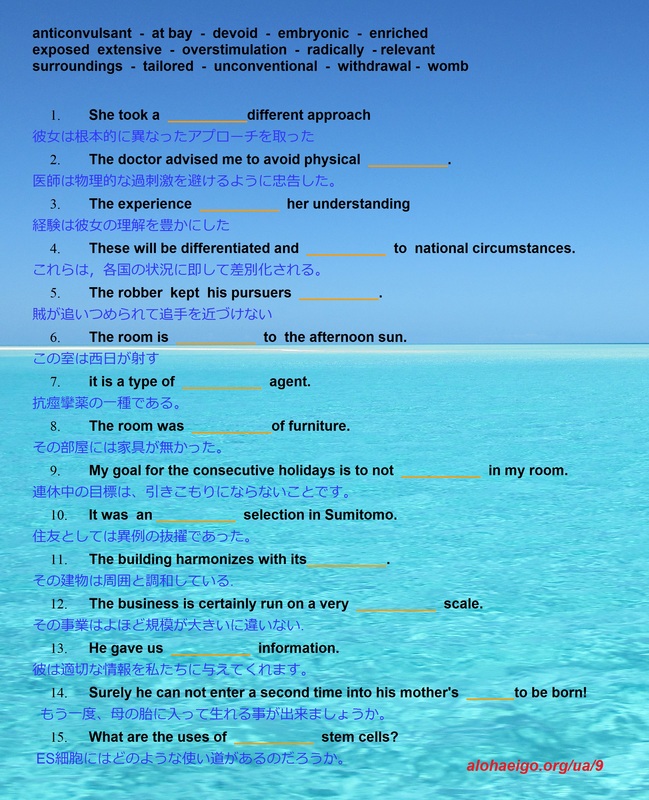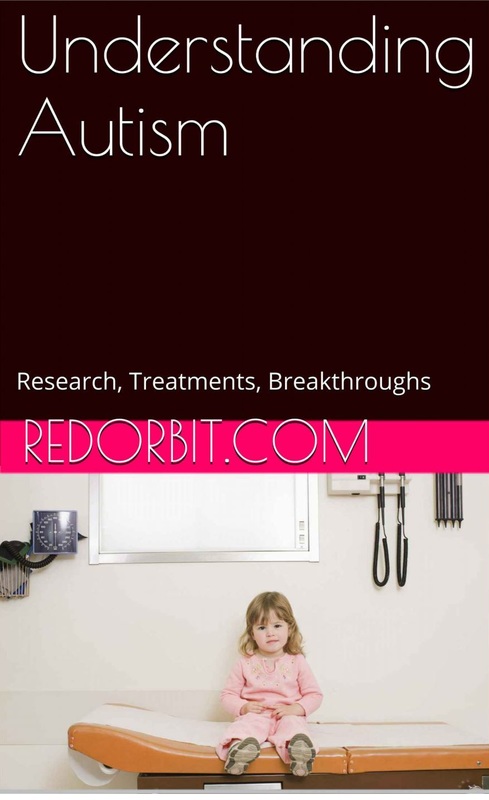Zinc found to reverse brain cell changes in autism
- I want to supplement his explanation.
私は彼の説明の補足をしたい。 - If not, the source network is not included in the subset.
そうではない場合、そのソース・ネットワークはそのサブセットに含まれない。 - Intriguingly, the white paper was issued under the instructions of the government.
興味深いことに、白書は政府の指示の下で出されました。 - My cognitive faculty is getting worse.
私の思考力は落ちています。 - My mom was hospitalized because of schizophrenia today.
今日、母が統合失調症が原因で入院しました。 - Parents can pass many diseases on to their offspring.
親が多くの病気を子どもに遺伝させる事がわかった。 - Price is regulated by demand and supply.
相場は需要供給より定まる - Some mushrooms are lethally toxic.
ある種のキノコは致死的に有毒である。 - Such materials have many technological applications.
このような材料は技術的アプリケーションが多くある。 - That has a low impact on the environment.
それは環境負荷が少ない。 - The illness has considerably weakened him.
その病気で彼はかなり弱った - The market share has grown significantly.
マーケットシェアは大きく伸びた。 - the place where neutrons meet together, called synapse
シナプスという,神経という器官どうしの接触部分 - There is dietary fiber in that.
その中には食物繊維が入っています。 - They have serious linguistic deficits
彼らには重大な言語障害がある - This happens due to genetic abnormalities.
これは遺伝子の異常により起こる。 - Thus, an optimum printed result is obtained.
これにより、最適な印刷結果を得ることが可能になる。 - We optimized the design of every component in the helmet.
ヘルメットの中のどの部品のデザインも最適化しました。 - We’ll consider the possibility of collaborative efforts.
協業の可能性を検討する - You can alter it any way you like.
それは自由に変更しても構いません。 - Your kidney function is bad.
腎機能が悪い。
Cellular changes in the brain caused by genetic mutations that occur in autism can be reversed by zinc, according to research at the University of Auckland.
Medical scientists at the University's Department of Physiology have researched aspects of how autism mutations change brain cell function for the past five years.
This latest work - a joint collaborative effort lead by neuroscientist collaborators in Auckland, America and Germany - was published today in the high impact journal, the Journal of Neuroscience.
The study was funded by the Marsden Fund and the Neurological Foundation.
Lead investigator at the University of Auckland, Associate Professor Johanna Montgomery from the University's Department of Physiology and Centre for Brain Research, says "This most recent work, builds significantly from our earlier work showing that gene changes in autism decrease brain cell communication."
"We are seeking ways to reverse these cellular deficits caused by autism-associated changes in brain cells," she says."This study looks at how zinc can alter brain cell communication that is altered at the cellular level and we are now taking that forward to look at the function of zinc at the dietary and behavior level."
"Autism is associated with genetic changes that result in behavioral changes," says Dr Montgomery. "It begins within the cells, so what happens at a behavioral level indicates something that has gone wrong at the cellular level in the brain."
International studies have found that normally there are high levels of zinc in the brain, and brain cells are regulated by zinc, but that zinc deficiency is prevalent in autistic children.
"Research using animal models has shown that when a mother is given a low zinc diet, the offspring will be more likely to display autistic associated behaviors," she says.
"Our work is showing that even the cells that carry genetic changes associated with autism can respond to zinc.
"Our research has focused on the protein Shank3, which is localized at synapses in the brain and is associated with neuro-developmental disorders such as autism and schizophrenia," she says.
"Human patients with genetic changes in Shank3 show profound communication and behavioral deficits. In this study, we show that Shank3 is a key component of a zinc-sensitive signaling system that regulates how brain cells communicate."
"Intriguingly, autism-associated changes in the Shank3 gene impair brain cell communication," says Dr Montgomery. "These genetic changes in Shank3 do not alter its ability to respond to zinc".
"As a result, we have shown that zinc can increase brain cell communication that was previously weakened by autism-associated changes in Shank3".
"Disruption of how zinc is regulated in the body may not only impair how synapses work in the brain, but may lead to cognitive and behavioral abnormalities seen in patients with psychiatric disorders."
"Together with our results, the data suggests that environmental/dietary factors such as changes in zinc levels could alter this protein's signaling system and reduce its ability to regulate the nerve cell function in the brain," she says.
This has applications to both autism and psychiatric disorders such as schizophrenia.
Dr Montgomery says the next stage of their research is to investigate the impact of dietary zinc supplements to see what impact it has on autistic behaviors.
"Too much zinc can be toxic, so it is important to determine the optimum level for preventing and treating autism and also whether zinc is beneficial for all or a subset of genetic changes that occur in Autism patients."
Medical scientists at the University's Department of Physiology have researched aspects of how autism mutations change brain cell function for the past five years.
This latest work - a joint collaborative effort lead by neuroscientist collaborators in Auckland, America and Germany - was published today in the high impact journal, the Journal of Neuroscience.
The study was funded by the Marsden Fund and the Neurological Foundation.
Lead investigator at the University of Auckland, Associate Professor Johanna Montgomery from the University's Department of Physiology and Centre for Brain Research, says "This most recent work, builds significantly from our earlier work showing that gene changes in autism decrease brain cell communication."
"We are seeking ways to reverse these cellular deficits caused by autism-associated changes in brain cells," she says."This study looks at how zinc can alter brain cell communication that is altered at the cellular level and we are now taking that forward to look at the function of zinc at the dietary and behavior level."
"Autism is associated with genetic changes that result in behavioral changes," says Dr Montgomery. "It begins within the cells, so what happens at a behavioral level indicates something that has gone wrong at the cellular level in the brain."
International studies have found that normally there are high levels of zinc in the brain, and brain cells are regulated by zinc, but that zinc deficiency is prevalent in autistic children.
"Research using animal models has shown that when a mother is given a low zinc diet, the offspring will be more likely to display autistic associated behaviors," she says.
"Our work is showing that even the cells that carry genetic changes associated with autism can respond to zinc.
"Our research has focused on the protein Shank3, which is localized at synapses in the brain and is associated with neuro-developmental disorders such as autism and schizophrenia," she says.
"Human patients with genetic changes in Shank3 show profound communication and behavioral deficits. In this study, we show that Shank3 is a key component of a zinc-sensitive signaling system that regulates how brain cells communicate."
"Intriguingly, autism-associated changes in the Shank3 gene impair brain cell communication," says Dr Montgomery. "These genetic changes in Shank3 do not alter its ability to respond to zinc".
"As a result, we have shown that zinc can increase brain cell communication that was previously weakened by autism-associated changes in Shank3".
"Disruption of how zinc is regulated in the body may not only impair how synapses work in the brain, but may lead to cognitive and behavioral abnormalities seen in patients with psychiatric disorders."
"Together with our results, the data suggests that environmental/dietary factors such as changes in zinc levels could alter this protein's signaling system and reduce its ability to regulate the nerve cell function in the brain," she says.
This has applications to both autism and psychiatric disorders such as schizophrenia.
Dr Montgomery says the next stage of their research is to investigate the impact of dietary zinc supplements to see what impact it has on autistic behaviors.
"Too much zinc can be toxic, so it is important to determine the optimum level for preventing and treating autism and also whether zinc is beneficial for all or a subset of genetic changes that occur in Autism patients."
http://medicalxpress.com/news/2016-08-zinc-reverse-brain-cell-autism.html



